Penthesilea Painter
The Penthesilea Painter (active between 470 and 450 BC at Athens) was a Greek vase painter of the Attic red-figure style. His true name is unknown. His conventional name is derived from his name vase, "bowl 2688" in Munich, the inside of which depicts the slaying of Penthesilea by Achilles. On the basis of that work, John Beazley attributed 177 known vases to the painter, about 100 of which only survive fragmentarily. Bowls, 149 in number, represent the bulk of his work. The rest is distributed among small shapes like skyphoi, kantharoi and bobbins.
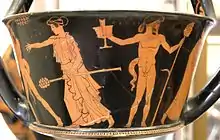

His work is characterised by large, space-filling figures whose posture is often bent so as to permit them to fit on a vessel. For the same reason, ornamental decoration around the edges is often very narrow. His works are also characterised by being very colourful, permitting several intermediate shades. Apart from dark coral red and the usual light red, he also used tones of brown, yellow, yellow-white and gold. His figures are painted remarkably meticulously in every detail. Unlike many of his contemporaries, he appears to have painted the subsidiary or exterior images on his vases himself. An exception is his very early "bowl T 212" at the Museo Archeologico Nazionale in Ferrara, with exterior images by the Splanchnoptes Painter. The Penthesilea Painter's works are dominated by depictions of boys and youths engaged in athletic activity, teaching scenes, weaponry and armour, as well as scenes of people talking to horses. While he painted the occasional mythological motif, they are so rare that they should be considered an exception among his work. Throughout his career, scenes from everyday life gain an increasingly dominant share of his paintings.
In his later works, his love of detail is lost and replaced with stencil-like motifs, their basic compositions indistinguishable from typical mass-produced wares. His lines become more casual, but don't lose their certainty, so that even these works preserve a distinctive charm, marking him as one of the great masters of Greek vase painting. His true mastery is increasingly found in the subsidiary images of boys, on which he appears to have concentrated more and more.
His major importance for Classical vase painting lies in the fact that he moved away from the usual motifs and replaced them with typical motifs from everyday life. His emphasis on human aspects represented a new departure and was to be an important influence on the further development of vase painting.
Apart from the Penthesilea bowl, "bowl 2689", also in Munich, is considered his other masterpiece. Its interior shows the slaying of Tityos by Apollo.
Selected works
| Name | Images | Dimensions | Type | Date | Description | Museum Record | |
|---|---|---|---|---|---|---|---|
| Berlin, Antikensammlung | |||||||
| bowl skyphos F 2591 | |||||||
| fragment of a skyphos 31573, V. 162 | |||||||
| Bologna, Museo Civico | |||||||
| fragment of a krater 289 | Image | ---- | Calyx krater | c.450 | Amazonomachy | ||
| bowl PU 272 | |||||||
| Boston, Museum of Fine Arts | |||||||
| skyphos 01.8032 | H. 23 cm; D. 23 cm | Red-figure skyphos | c.450 BC | Maenads and Pans | Record | ||
| bowl 03.815 | H. 15.5 cm | red-figure kylix | c.460 BC | Int: Nymph with scepter and vase; Ext: Two women and four youths | Record | ||
| bowl 13.84 | H. 27 cm; D. 27 cm | red-figure kylix | c.450 BC | Int: Youth talking to woman; Ext: Satyrs and Maenads | Record | ||
| bowl 28.48 | H. 9.8 cm; D. 23.8 cm | red-figure kylix | c.460 BC | Int: Two boys talking; Ext: Boys at the gymnasium | Record | ||
| Cambridge, Massachusetts, Harvard University Art Museums | |||||||
| kylix 1925.30.130 | H. 11.3 cm.; D. 27.3 cm | Attic Red Figure kylix | 470-460 BC | Int: Satyr and maenad; ExtA: Warrior presented to Zeus by Iris; ExtB: Departing warrior, with Iris. | |||
| Chicago, IL, Art Institute of Chicago | |||||||
| Kylix 1889.27 | Attic Red-figure kylix | 460 BC | Int: Youth with woman. | Record | |||
| Ferrara, Museo Archeologico Nazionale | |||||||
| bowl T 18 C |  |  | ---- | Attic Red-figure kylix | 460-450 BC | Int: Apotheosis of Theseus, Ext: Combat | |
| bowl T 212 | |||||||
| Hamburg, Museum für Kunst und Gewerbe | |||||||
| bowl 1900.164 | Images | ---- | Red-figure kylix | c.450 BC | Int: boy seated with lyre, and youth; Ext: youths and horses | ||
| London, British Museum | |||||||
| bowl E 72 | |||||||
| Madison, Wisconsin, Chazen Museum of Art | |||||||
| Kylix 1976.31 | H. 15.25 cm; D. 45.56 cm | Red-figure kylix | c.455 BC | Int: Theseus fighting the bull of Marathon | Record | ||
| Munich, Glyptothek and Antikensammlung | |||||||
| kantharos 2565 | |||||||
| Penthesilea bowl (2688) |  | H. 7 cm; D. 43 cm | Attic red-figure kylix | 470–460 BC | Achilles killing Penthesilea | ||
| bowl 2689 | 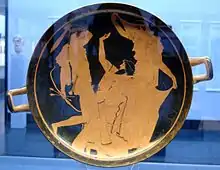 | H. 7 cm; D. 40 cm | Attic red-figure kylix | 460–450 BC | Apollo, Tityos and a goddess (probably Gaia defending her son, or Leto). | ||
| New York, Metropolitan Museum of Art | |||||||
| skyphos 06.1079 | H. 16.2 cm; D. 30.2 cm | Red-figure skyphos | c.460 BC | A & B: A young man goes to war | Record | ||
| pyxis 07.286.36 | 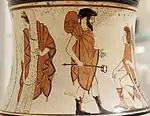 |  | H. 12.1 cm D. 17.2 cm | Attic white-ground pyxis with lid | 460-450 | The Judgement of Paris | Record |
| bobin 28.167 | 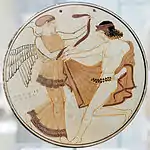 |  | D. 12.8 cm | Attic white-ground bobbin | 460-450 BC | A: Nike & a youth; B: Eros and a youth | Record |
| bowl 41.162.9 | H. 16.4 cm; D. 36.7 cm | Red-figure kylix | c.460 BC | Int: Man hunting boar; Ext: Athletes | Record | ||
| Oxford, Ashmolean Museum | |||||||
| bowl 1931.12 | Image | Red-figure kylix | c.450 | Int: Nike dressing a bull for sacrifice | |||
| Paris, Bibliothèque Nationale (Cabinet des Médailles) | |||||||
| De Ridder 814 | _e_scene_di_armamento_(ext)%252C_atene_480-450_ac_ca._01.JPG.webp) | _e_scene_di_armamento_(ext)%252C_atene_480-450_ac_ca._02.JPG.webp) | H. 12.6 cm, L. 41.9 cm, D. 33.7 cm | Red-figure kylix | 480 - 450 BC | Int: Horseman; Ext: Arming scene | Record |
| De Ridder 849 |  | H. 28.9 cm, L. 28.2 cm, D. 20.6 cm | Red-figure kantharos | c.460 BC | Satyrs and Maenads | Record | |
| Paris, Musée National du Louvre | |||||||
| bowl G 382 | |||||||
| bowl G 448 | 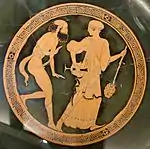 | H. 16.50 cm; L. 44.80 cm; D. 36.10 cm | Attic red-figure kylix | 460–450 BC | Int: Silenus and maenad | ||
| Philadelphia, University Museum | |||||||
| hydria L-64-41 | Image | dimensions | Red-figure hydria | 460-450 BC | Three women in a domestic scene | ||
| kylix L-637-1a | Image | H. 12.5 cm; D. 45.7 cm | Red-figure kylix | 520-420 BC | Int: Boy propositioning a girl; Ext: Departure of young horsemen | ||
| kylix MS 2495 | Image | H. 9 cm; D. 24 cm | Red-figure kylix | 475-450 BC | Int: Two boys facing; Ext: Nike and young citizens | ||
| kylix MS 5693 | Image | H. 7.8 cm; D. 29 cm | Red-figure kylix | 460-450 BC | Int: Two boys at the gymnasium; Ext: Nike parts a boy and a man | ||
| Vienna, Kunsthistorisches Museum | |||||||
| bowl 3700 | |||||||
Bibliography
- Hans Diepolder. Der Penthesilea-Maler. Leipzig 1936. (Bilder griechischer Vasen, 10).
- John Beazley. Attic Red Figure Vase Painters. Oxford: Clarendon Press, 1963
External links
| Wikimedia Commons has media related to Penthesilea Painter. |